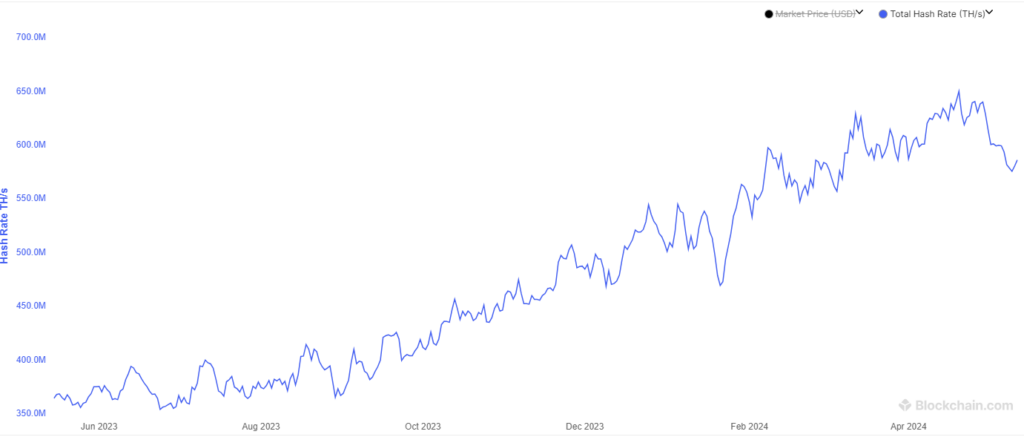In recent weeks, the Bitcoin network has experienced a notable decline in hashrate, reflecting a shift within the mining landscape as operators adapt to changing market dynamics. This decrease is attributed to miners switching off less profitable rigs after the fourth Bitcoin halving.

The drop in hashrate, which bottomed out at a two-month low of 575 exahash per second (EH/s) on May 10 before rebounding to around 586 EH/s, according to blockchain.com data, highlights a critical juncture for Bitcoin mining operations. As older, less efficient mining rigs become economically unviable, companies are recalibrating their strategies to optimize profitability amid evolving market conditions.
One key factor contributing to this shift is the reduced block rewards which placed additional pressure on mining margins. The cost of electricity remains a pivotal determinant of mining profitability, with certain older ASIC models proving unsustainable at higher electricity prices.
However, industry leaders like TeraWulf, one of the world’s largest Bitcoin mining companies, are navigating this landscape with strategic expansions despite the challenges posed by reduced block rewards. TeraWulf emphasized that while smaller operations with outdated equipment may face risks post-halving, larger players are leveraging scale and efficiency to sustain operations.
Projections indicate a rebound in hashrate, with models forecasting a rise to 700 exahash by 2025. This resurgence is anticipated post-halving, following a potential short-term decline of up to 10% as miners adjust their operations.
Another concern is the potential for a broader Bitcoin sell-off, driven by miners’ urgent need to manage cash flows. Mining companies like Marathon Digital, holding substantial Bitcoin reserves valued at $1.1 billion, could significantly impact market dynamics with even a partial liquidation of holdings, given the current lower market liquidity.
The looming sell-off underscores broader market vulnerabilities amid the ongoing evolution of Bitcoin mining economics. While the halving event aims to ensure scarcity and value appreciation over time, its immediate impact introduces short-term challenges for miners adjusting to reduced rewards.
In response, industry participants are exploring strategic measures to optimize operational efficiency and mitigate revenue pressures. Efforts to lower energy costs, upgrade to more efficient mining hardware, and retiring old miners are essential to navigating this period of market adjustment.
Beyond these shifts, the declining revenues of miners have sparked concerns about potential sell-offs in Bitcoin holdings. As mining rewards decrease and transaction fees dip, miners are under pressure to cover operational costs, leading to potential market impacts due to the liquidation of assets.
The broader narrative surrounding this decline underscores a pivotal moment for the cryptocurrency mining sector. Companies are increasingly focused on optimizing energy usage, enhancing mining efficiency, and securing favorable procurement terms to weather market fluctuations.










